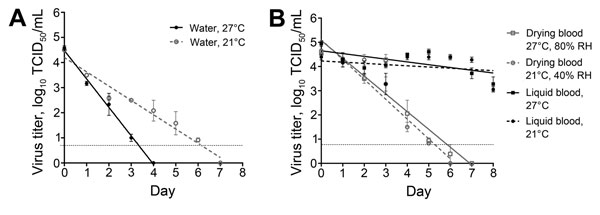Volume 21, Number 7—July 2015
Dispatch
Ebola Virus Stability on Surfaces and in Fluids in Simulated Outbreak Environments
Figure 2

Figure 2. Linear regression model showing stability of Ebola virus (EBOV) in fluids under different environmental conditions. A) EBOV stability in water at 2 environmental temperatures. Virus concentration was reduced at a significantly faster rate in 27°C water than in 21°C water (p = 0.0001). B) Stability in drying or liquid EBOV-spiked human blood samples at 2 environmental conditions. Virus concentration was reduced at a significantly faster rate by drying than in liquid blood at both conditions (p<0.0001 for each condition). No significant difference between reduction rates in virus titer in drying human blood at both conditions was found (p = 0.92). Triplicate samples were taken at each time point. Error bars indicate mean ± SEM virus titer. Dashed line indicates the limit of detection for the assay. An analysis of covariance equivalent test was used to compare linear regression models and determine differences in virus reduction rates. TCID50, 50% tissue culture infectious dose.
1These authors contributed equally to this article.